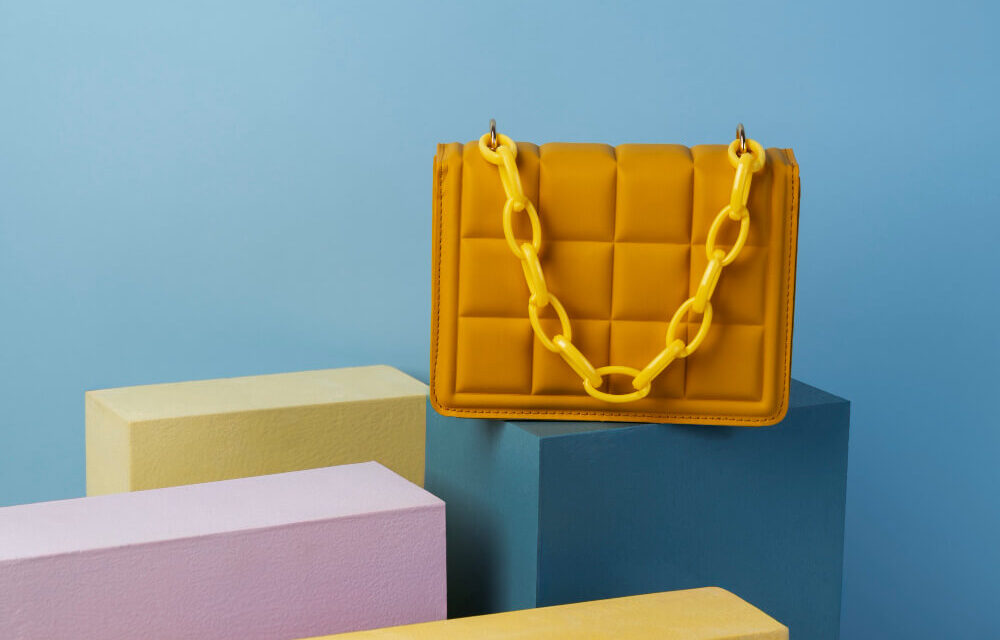Goyard’s signature patterns centre on the distinctive Goyardine canvas, introduced in 1892 by Edmond Goyard. The design features a chevron pattern inspired by log-driving traditions, with three chevrons forming a ‘Y’ to symbolize the family name. Created from a durable blend of hemp, linen, and cotton with a waterproof coating, this iconic pattern represents both craftsmanship and heritage. The intricate details behind this legendary design reveal a fascinating story of innovation and tradition.
Highlights
- The iconic Goyard chevron pattern features three Y-shaped chevrons, symbolizing the family name and brand’s heritage in log driving.
- Introduced in 1892, Goyardine canvas combines hemp, linen, and cotton with a waterproof coating for durability and distinction.
- Hand-painted patterns evolved from bold, vibrant designs to include seasonal variations and custom colour options.
- Multiple paint layers and artisanal techniques showcase Goyard’s commitment to exceptional craftsmanship dating back to 1792.
- The signature pattern merges traditional French heritage with contemporary aesthetics while maintaining historical authenticity.
The Legacy of Goyardine Canvas
A marvel of textile innovation, the Goyardine canvas stands as one of the most significant contributions to luxury fashion history. Introduced in 1892 by Edmond Goyard, this distinctive material blends hemp, linen, and cotton, creating a durable yet flexible fabric that captures the essence of Goyardine nostalgia.
The canvas’s development reflects both creativity and practicality, featuring a waterproof coating and the iconic chevron pattern inspired by the Goyard family’s logging heritage. The canvas versatility shines through its adaptation from traditional trunks to modern handbags. The pattern’s intricate design was originally handpainted by artisans before evolving to include etching and dyeing techniques. After a pause in production following World War II, the material’s revival in 1998 marked a new chapter in its legacy. The manufacturing process, while incorporating modern techniques, maintains its secretive nature and commitment to traditional craftsmanship.
Decoding the Chevron Pattern’s Symbolism
The intricate Chevron pattern adorning Goyard’s luxury goods carries deep symbolic meaning rooted in the company’s heritage. The design originated from the company’s ancestral connection to log driving, where river workers marked their timber with distinctive symbols. The Chevron meaning extends beyond this historical reference, as the pattern’s three chevrons cleverly form a ‘Y’, representing the central letter in the Goyard name.
The pattern evolution shows remarkable consistency while adapting to modern luxury standards. Edmond Goyard integrated this design element as his artistic signature, much like a painter signing their masterpiece. The creation of the iconic Goyardine canvas in 1892 revolutionized the brand’s visual identity. Today, the Chevron pattern serves as both a representation of Goyard’s craftsmanship and a symbol of understated elegance, distinguishing the brand in the luxury market without relying on obvious branding.
Historical Craftsmanship and Innovation
Since its establishment in 1792 by Pierre-François Martin, Goyard’s legacy of craftsmanship has set unprecedented standards in luxury goods manufacturing. The company’s artisan techniques, developed through generations of skilled craftsmen, transformed trunk history with innovative approaches to design and functionality.
Under François Goyard’s leadership in 1852, the company enhanced its manufacturing processes while maintaining meticulous quality control. The most significant innovation came in 1892 when Edmond Goyard created the Goyardine canvas, a durable material made from hemp, linen, and cotton with a waterproof coating.
This breakthrough marked Goyard as the first trunk maker to incorporate branding directly into its products. The distinctive manufacturing process, involving multiple layers of paint to create raised patterns, established a level of craftsmanship that continues to distinguish the brand today. The company later expanded its creative palette when twelve new colours were introduced to the Goyardine canvas in 2002.
Evolution of Colors and Materials
Building upon Goyard’s innovative craftsmanship, colour and material developments have shaped the brand’s distinctive identity throughout its history. From its initial hand-painted designs to mechanized production, Goyard has maintained a delicate balance between tradition and progress. The brand’s commitment to material sustainability is evident in its custom blend of hemp, linen, and cotton canvas, enhanced by Edmond Goyard’s waterproof coating innovation. The Goyardine print remains the company’s most recognizable design element, featuring interlocking Ys and piled dots that symbolize the brand’s heritage.
| Era | Colour Trends | Material Innovations |
|---|---|---|
| Early | Bold, vibrant hand-painted | Basic canvas |
| Mid | Expanded color range | Waterproof coating added |
| Modern | Seasonal variations | Hemp-linen-cotton blend |
| Current | Custom colour options | Mechanized etching |
While adapting to modern production methods, Goyard maintains its dedication to quality through careful material selection and precise color application techniques, ensuring each piece reflects the brand’s heritage.
Cultural Heritage in Modern Design
While preserving cultural identity remains paramount in modern design, Goyard’s approach to integrating heritage elements demonstrates how tradition can successfully merge with contemporary aesthetics. The brand incorporates cultural motifs that reflect its French heritage while adapting to modern sensibilities and global design context.
The integration of traditional elements into contemporary designs helps maintain a connection between past and present, fostering a sense of authenticity and historical continuity. Through careful preservation of its signature patterns, Goyard exemplifies how cultural heritage can be maintained while embracing innovation. This balance allows the brand to create products that resonate with modern consumers while honouring its rich history. The unique practice of marking river logs, which influenced the company’s founding in 1853, continues to inspire their distinctive design elements today. The result is a unique blend of historical craftsmanship and contemporary appeal that sets the brand apart in today’s luxury market.










